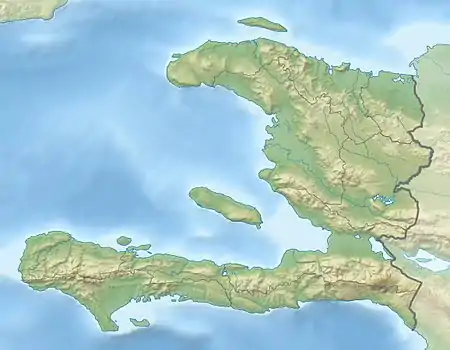Eleutherodactylus amadeus
Eleutherodactylus amadeus, also known as Mozart's frog[2] or Haitian robber frog,[3] is a species of frog in the family Eleutherodactylidae. It is endemic to the Massif de la Hotte, southwestern Haiti.[3] After not having been seen after 1991, the species was reported again in 2011.[2]
| Eleutherodactylus amadeus | |
|---|---|
| Scientific classification | |
| Domain: | Eukaryota |
| Kingdom: | Animalia |
| Phylum: | Chordata |
| Class: | Amphibia |
| Order: | Anura |
| Family: | Eleutherodactylidae |
| Genus: | Eleutherodactylus |
| Subgenus: | Euhyas |
| Species: | E. amadeus |
| Binomial name | |
| Eleutherodactylus amadeus | |
Etymology

Eleutherodactylus amadeus is named after the composer Wolfgang Amadeus Mozart "for the remarkable resemblance of the wide-band audiospectrogram of this species to musical notes."[4]
Description

Males measure on average 18.7 mm (0.74 in) and females 23.4 mm (0.92 in) in snout–vent length.[4] The maximum length is 25 mm (0.98 in).[2] The dorsum is smooth. The dorsal pattern is variable; the most common patterns are reverse parentheses [")("], unpatterned, and narrow middorsal stripe combined with long dorsolateral stripes.[4]
Reproduction
Male advertisement call is a single four-note call, emitted from low herbaceous vegetation or from the ground. Similar two-note calls have been heard in late afternoon and early evening, although there is no certainty that they belong to this species. After darkness, only four-note calls are heard. Egg cluster have been found under objects on the ground. Clutch size is 11–12; egg clusters might contain eggs from more than one female.[4] The development is direct (i.e., without free-living tadpole stage).[1] The hatchlings measure 4.2–4.4 mm (0.17–0.17 in).[4]
Habitat and conservation
Its natural habitat is closed-canopy forest at elevations of 1,000–2,340 m (3,280–7,680 ft) above sea level. In daytime they hide under rocks and logs. Males can be heard calling in the early evening from low herbaceous vegetation.[1]
It is threatened by habitat loss, primarily caused by logging (for charcoaling) and slash-and-burn agriculture. It occurs in the Pic Macaya National Park. However, there is no active management for conservation, and habitat loss continues in the park.[1] After not having been seen after 1991, the species was rediscovered during an expedition that was part of the Conservation International’s global search for "lost frogs". The finding was announced in early 2011.[2]
References
- Blair Hedges, Richard Thomas, Robert Powell (2004). "Eleutherodactylus amadeus". IUCN Red List of Threatened Species. 2004: e.T56409A11471744. doi:10.2305/IUCN.UK.2004.RLTS.T56409A11471744.en. Retrieved 16 November 2021.
{{cite journal}}: CS1 maint: multiple names: authors list (link) - "Mozart and ventriloquial frogs sound a note of hope and warning for Haiti's recovery". IUCN. 12 January 2011. Retrieved 28 December 2016.
- Frost, Darrel R. (2016). "Eleutherodactylus amadeus Hedges, Thomas, and Franz, 1987". Amphibian Species of the World: an Online Reference. Version 6.0. American Museum of Natural History. Retrieved 28 December 2016.
- Hedges, S. Blair; Thomas, Richard; Franz, Richard (1987). "A new species of Eleutherodactylus (Anura, Eleutherodactylidae) from the Massif de la Hotte, Haiti" (PDF). Copeia. 1987 (4): 943–949. doi:10.2307/1445557. JSTOR 1445557.
